2003 GMC SIERRA DENALI park assist
[x] Cancel search: park assistPage 82 of 428

Section 2 Features and Controls
Keys ............................................................... 2-2
Remote Keyless Entry System
......................... 2-3
Remote Keyless Entry System Operation
........... 2-4
Doors and Locks
............................................. 2-6
Door Locks
.................................................... 2-6
Power Door Locks
.......................................... 2-7
Rear Doors
................................................... 2-8
Tailgate
........................................................ 2-8
Windows
........................................................ 2-10
Power Windows
............................................ 2-11
Swing-Out Windows
...................................... 2-11
Sun Visors
................................................... 2-12
Theft-Deterrent Systems
.................................. 2.13
Content Theft-Deterrent
................................. 2.13
Passlock@
.................................................... 2.14
Starting and Operating Your Vehicle
................ 2.15
New Vehicle Break-In
.................................... 2.15
Ignition Positions
.......................................... 2.15
Starting Your Engine
..................................... 2.16
Engine Coolant Heater
.................................. 2.17
Automatic Transmission Operation
................... 2.18
All-Wheel Drive
............................................ 2-21
Parking Brake
.............................................. 2-22
Shifting Into Park
(P) ..................................... 2-23 Shifting
Out
of Park (P) ................................. 2-25
Parking Over Things That Burn
....................... 2-26
Engine Exhaust
............................................ 2-26
Running Your Engine While You Are Parked
.... 2-27
Mirrors
........................................................... 2-28
Automatic Dimming Rearview Mirror with
OnStap, Compass and Temperature
Display
.................................................... 2-28
Outside Power Mirrors
................................... 2-31
Outside Power Foldaway Mirrors
..................... 2-31
Outside Automatic Dimming Mirror
.................. 2-31
Outside Curb View Assist Mirrors
.................... 2-32
Outside Convex Mirror
................................... 2-32
Outside Heated Mirrors
.................................. 2-32
Onstar@ System
............................................. 2-33
HomeLink@ Transmitter
................................... 2-35
Programming the HomeLink Transmitter
........... 2-35
Storage Areas
................................................ 2-39
Glove Box
................................................... 2-39
Cupholder(s)
................................................ 2-39
Center Console Storage Area
......................... 2-39
Tonneau Cover
............................................ 2-39
Vehicle Personalization
................................... 2-42
Memory Seat
............................................... 2-42
2- 1
Page 113 of 428
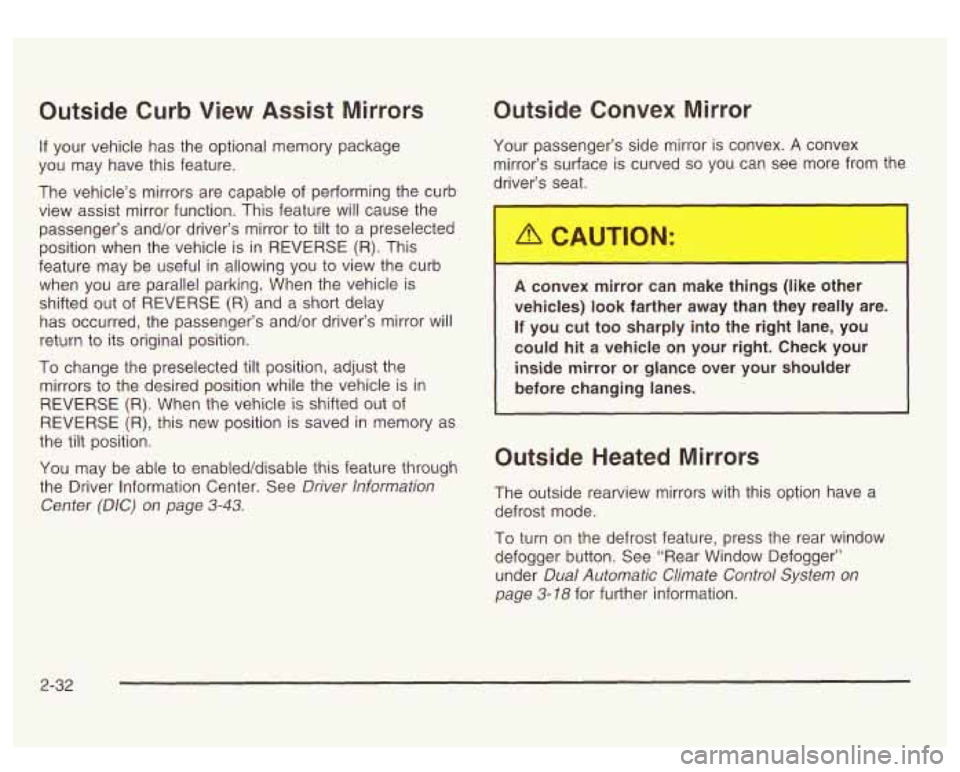
Outside Curb View Assist Mirrors
If your vehicle has the optional memory package
you may have this feature.
The vehicle’s mirrors are capable of performing the curb
view assist mirror function. This feature will cause the
passenger’s and/or driver’s mirror to tilt to a preselected
position when the vehicle is in REVERSE (R). This
feature may be useful in allowing you to view the curb
when you are parallel parking. When the vehicle
is
shifted out of REVERSE (R) and a short delay
has occurred, the passenger’s and/or driver’s mirror will
return to its original position.
To change the preselected tilt position, adjust the
mirrors to the desired position while the vehicle is in
REVERSE (R). When the vehicle is shifted out of
REVERSE (R), this new position is saved in memory as
the tilt position.
You may be able to enabled/disable this feature through
the Driver Information Center. See
Driver Information
Center (DIC) on page
3-43.
Outside Convex Mirror
Your passenger’s side mirror is convex. A convex
mirror’s surface is curved
so you can see more from the
driver’s seat.
A convex mirror can make things (like other
vehicles)
look farther away than they really are.
If you cut too sharply into the right lane, you
could hit a vehicle on your right. Check your
inside mirror or glance over your shoulder
before changing lanes.
Outside Heated Mirrors
The outside rearview mirrors with this option have a
defrost mode.
To turn on the defrost feature, press the rear window
defogger button. See “Rear Window Defogger”
under
Dual Automatic Climate Control System on
page 3-18 for further information.
2-32
Page 162 of 428
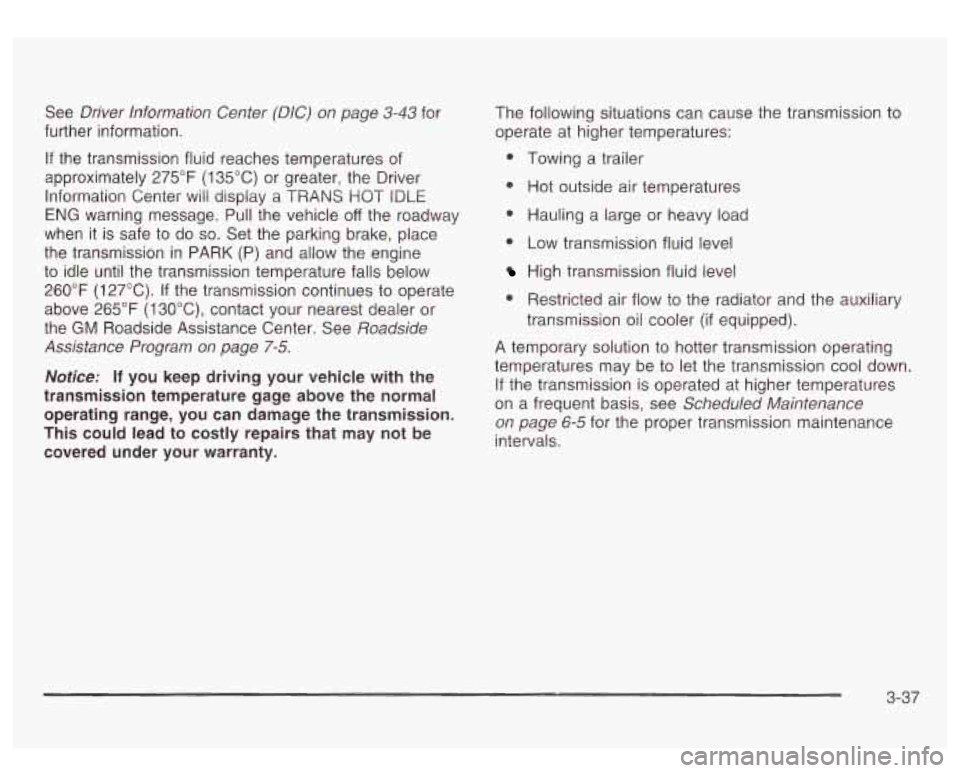
See Driver Information Center (DIC) on page 3-43 for
further information.
If the transmission fluid reaches temperatures of
approximately 275°F
(1 35°C) or greater, the Driver
Information Center wiil display a
TRANS HOT IDLE
ENG warning message. Pull the vehicle off the roadway
when it
is safe to do so. Set the parking brake, place
the transmission in PARK
(P) and allow the engine
to idle until the transmission temperature falls below
260°F (1 27°C). If the transmission continues to operate
above
265°F (13O"C), contact your nearest dealer or
the
GM Roadside Assistance Center. See Roadside
Assistance Program
on page 7-5.
Notices If you keep driving your vehicle with the
transmission temperature gage above the normal
operating range, you can damage the transmission.
This could lead to costly repairs that may not be
covered under your warranty. The
following situations can cause the transmission to
operate at higher temperatures:
0 Towing a trailer
0 Hot outside air temperatures
0 Hauling a large or heavy load
0 Low transmission fluid level
High transmission fluid level
0 Restricted air flow to the radiator and the auxiliary
transmission oil cooler
(if equipped).
A temporary solution to hotter transmission operating
temperatures may be to let the transmission cool down.
If the transmission is operated at higher temperatures
on a frequent basis, see
Scheduled Maintenance
on page
6-5 for the proper transmission maintenance
intervals.
3-37
Page 218 of 428
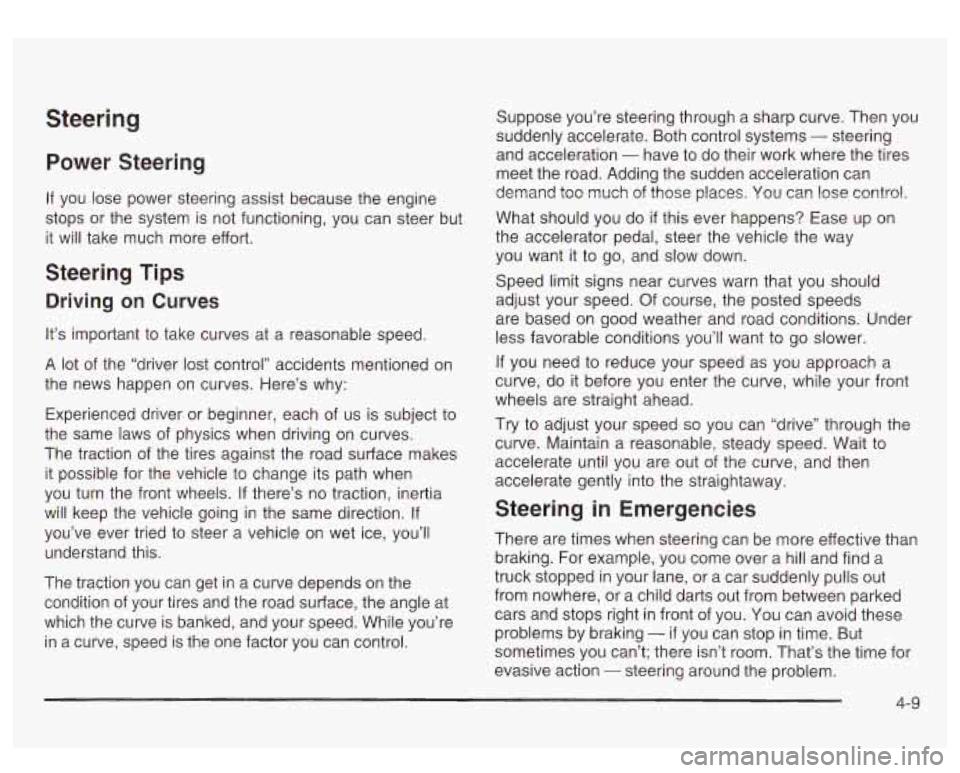
Steering
Power Steering
If you lose power steering assist because the engine
stops or the system is not functioning, you can steer but
it will take much more effort.
Steering Tips
Driving on Curves
It’s important to take curves at a reasonable speed.
A lot of the “driver lost control” accidents mentioned on
the news happen on curves. Here’s why:
Experienced driver or beginner, each of us is subject to
the same laws of physics when driving on curves.
The traction of the tires against the road surface makes
it possible for the vehicle to change its path when
you turn the front wheels.
If there’s no traction, inertia
will keep the vehicle going in the same direction.
If
you’ve ever tried to steer a vehicle on wet ice, you’ll
understand this.
The traction you can get in a curve depends on the
condition of your tires and the road surface, the angle at
which the curve is banked, and your speed. While you’re
in a curve, speed
is the one factor you can control. Suppose
you’re steering through a sharp curve. Then you
suddenly accelerate. Both control systems
- steering
and acceleration
- have to do their work where the tires
meet the road. Adding the sudden acceleration can
demand too much of those places. You can
lose control.
What should you do
if this ever happens? Ease up on
the accelerator pedal, steer the vehicle the way
you want
it to go, and slow down.
Speed limit signs near curves warn that you should
adjust your speed. Of course, the posted speeds
are based on good weather and road conditions. Under
less favorable conditions you’ll want to go slower.
If you need to reduce your speed as you approach a
curve, do it before you enter the curve, while your front
wheels are straight ahead.
Try to adjust your speed
so you can “drive” through the
curve. Maintain a reasonable, steady speed. Wait to
accelerate until you are out of the curve, and then
accelerate gently into the straightaway.
Steering in Emergencies
There are times when steering can be more effective than
braking. For example, you come over a hill and find a
truck stopped in your lane, or a car suddenly pulls out
from nowhere, or a child darts out from between parked
cars and stops right in front of you. You can avoid these
problems by braking
- if you can stop in time. But
sometimes you can’t; there isn’t room. That’s the time for
evasive action
- steering around the problem.
4-9
Page 404 of 428
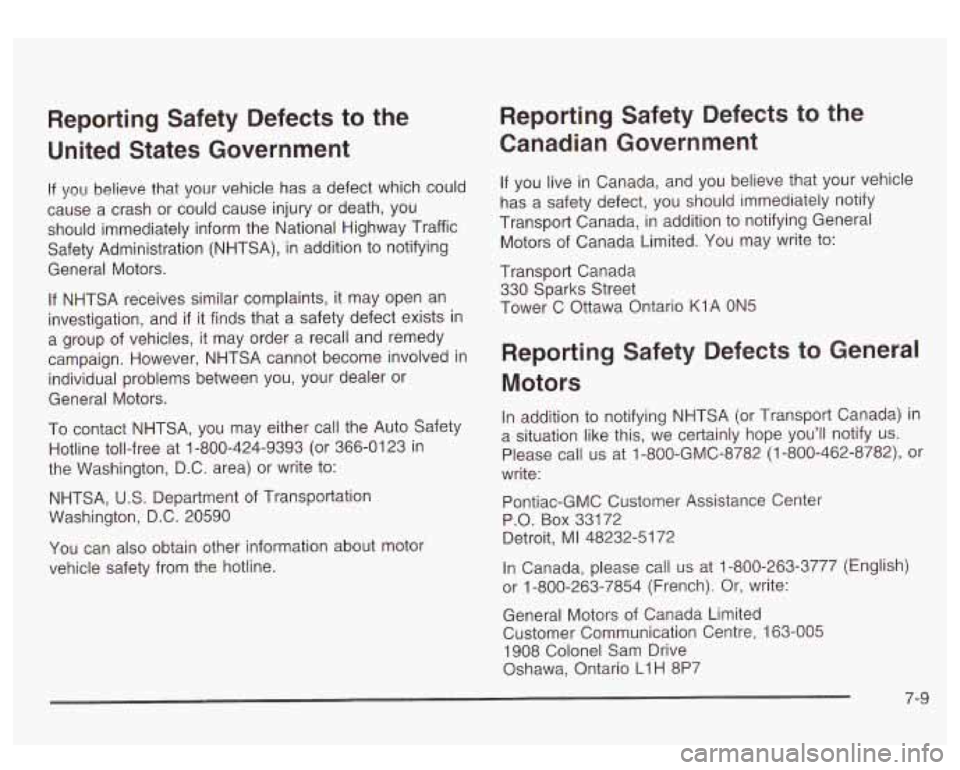
Reporting Safety Defects to the
United States Government
If you believe that your vehicle has a defect which could
cause a crash or could cause injury or death, you
should immediately inform the National Highway Traffic
Safety Administration (NHTSA), in addition to notifying
General Motors.
If NHTSA receives similar complaints, it may open an
investigation, and
if it finds that a safety defect exists in
a group of vehicles, it may order a recall and remedy
campaign. However, NHTSA cannot become involved in
individual problems between you, your dealer or
General Motors.
To contact NHTSA, you may either call the Auto Safety
Hotline toll-free at 1-800-424-9393 (or 366-0123 in
the Washington, D.C. area) or write to:
NHTSA,
U.S. Department of Transportation
Washington, D.C. 20590
You can also obtain other information about motor
vehicle safety from the hotline.
Reporting Safety Defects to the
Canadian Government
If you live in Canada, and you believe that your vehicle
has a safety defect, you should immediately notity
Transport Canada, in addition to notifying General
Motors of Canada Limited. You may write to:
Transport Canada
330 Sparks Street
Tower C Ottawa Ontario KIA ON5
Reporting Safety Defects to General
Motors
In addition to notifying NHTSA (or Transport Canada) in
a situation like this, we certainly hope you’ll notify us.
Please call
us at 1 -800-GMC-8782 (1 -800-462-8782), or
write:
Pontiac-GMC Customer Assistance Center P.O.
Box 33172
Detroit, MI 48232-51 72
In Canada, please call
us at 1-800-263-3777 (English)
or 1-800-263-7854 (French). Or, write:
General Motors of Canada Limited
Customer Communication Centre, 163-005
1908 Colonel Sam Drive
Oshawa, Ontario LIH 8P7
7-9
Page 411 of 428
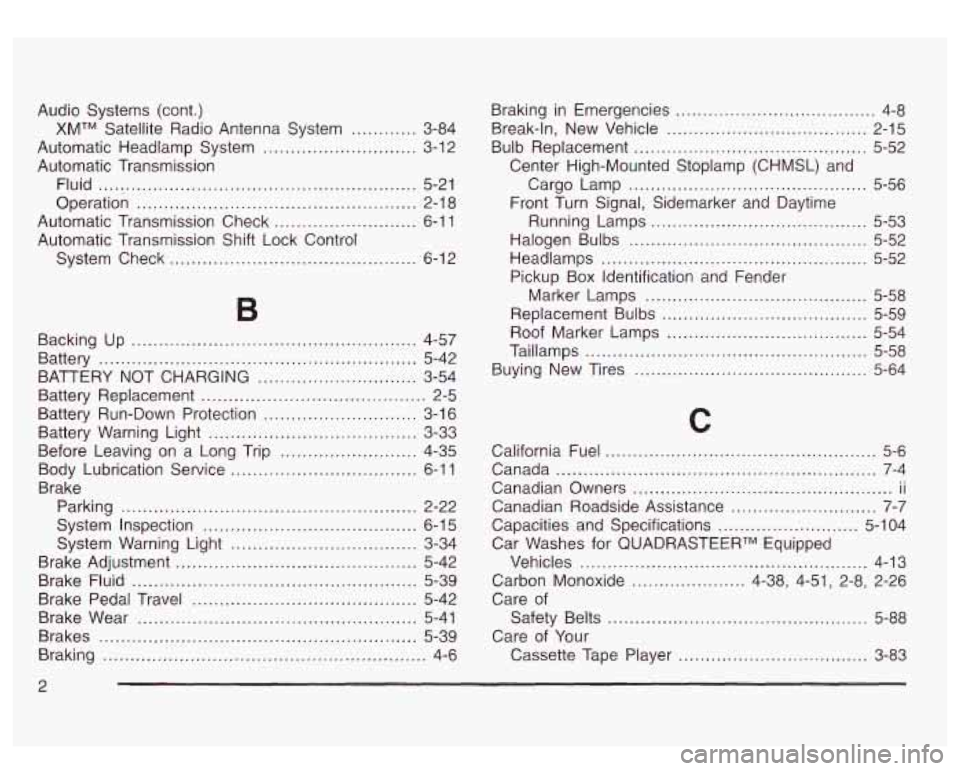
Audio Systems (cont.)
XMTM Satellite Radio Antenna System ............ 3-84
Automatic Headlamp System
............................ 3-1 2
Operation ................................................... 2-1 8
System Check
......................................... 6-12
Automatic
Transmission
Fluid
.......................................................... 5-21
Automatic Transmission Check
.......................... 6-1 1
Automatic Transmission Shift Lock Control
B
Backing Up .................................................... 4-57
Battery
.......................................................... 5-42
Battery Replacement
......................................... 2-5
Battery Run-Down Protection ............................ 3-1 6
BATTERY NOT CHARGING
............................. 3-54
Battery Warning Light
...................................... 3-33
Before Leaving on a Long Trip
......................... 4-35
Body Lubrication Service
.................................. 6-1 1
Brake Parking
...................................................... 2-22
System Inspection
....................................... 6-1 5
System Warning Light .................................. 3-34
Brake Adjustment
............................................ 5-42
Brake Fluid
.................................................... 5-39
Brake Pedal Travel
......................................... 5-42
Brake Wear
.................................... ....... 5-41
Brakes
.......................................................... 5-39
Braking ........................................................... 4-6 Braking
in Emergencies
..................................... 4-8
Break-In, New Vehicle
..................................... 2-15
Bulb Replacement
........................................... 5-52
Center High-Mounted Stoplamp (CHMSL) and
Cargo Lamp
............................................ 5-56
Front Turn Signal, Sidemarker and Daytime
Running Lamps
........................................ 5-53
Halogen Bulbs
............................................ 5-52
Headlamps
................................................. 5-52
Pickup Box Identification and Fender
Marker Lamps
......................................... 5-58
Replacement Bulbs
...................................... 5-59
Roof Marker Lamps
..................................... 5-54
Buying New Tires
........................................... 5-64
Taillamps
.................................................... 5-58
C
California Fuel .................................................. 5-6
Canada
........................................................... 7-4
Canadian Owners
................................................ ii
Canadian Roadside Assistance ........................... 7-7
Capacities and Specifications
.......................... 5-1 04
Car Washes for QUADRASTEERTM Equipped Vehicles
..................................................... 4-13
Carbon Monoxide
..................... 4-38, 4-51, 2-8, 2-26
Care of
Safety Belts
................................ ..... 5-88
Care
of Your
Cassette Tape Player
................................... 3-83
2
Page 419 of 428

OIL PRESSURE LOW ..................................... 3-54
Older Children. Restraints
................................ 1-30
Online Owner Center ........................................ 7-3
Onstar@ Personal Calling
................................. 2-34
Onstar@ Services
............................................ 2-33
Onstar@ Steering Wheel Controls
...................... 2-34
Onstar@ System
............................................. 2-33
Onstar@ Virtual Advisor
.................................... 2-34
Operating Your All-Wheel-Drive Vehicle
Off
Paved Roads ..................
Other Warning Devices ........
Outlet Adjustment ................
Outside
Automatic Dimming Mirror
.
Convex Mirror .................
Curb View Assist Mirrors ..
Heated Mirrors ................
Power Foldaway Mirrors ...
...
......................... 4-16
........................... 3-4
......................... 3-23
......................... 2-31
......................... 2-32
......................... 2-32
......................... 2-32
......................... 2-31
Power Mirrors
............................................. 2-31
Overheated Engine Protection
Operating Mode
.......................................... 5-27
Owners, Canadian
............................................... ii
Owner’s Information ........................................ 7-1 0
P
Park (P)
Parking Shifting
Out
of ............................................ 2-25
Brake
........................................................ 2-22
Over Things That Burn
................................. 2-26
Park (P) Mechanism Check
........................... 6-13
Parking on
Hills .............................................. 4-58
Shifting Into
................................................ 2-23
Parking
Brake and Automatic Transmission
Park (P)
Part A
- Scheduled Maintenance Services ............ 6-4
Part B
- Owner Checks and Services ................ 6-10
Part C
- Periodic Maintenance Inspections .......... 6-14
Part D
- Recommended Fluids and Lubricants .... 6-16
Part E
- Maintenance Record ........................... 6-18
Passenger Air Bag Indicator
............................. 2-30
Passenger Air Bag Status Indicator
................... 3-30
PASSENGER DOOR AJAR
.............................. 3-60
Passenger Sensing System
.............................. 1-68
Passing
......................................................... 4-14
Passlock@
...................................................... 2-14
10
Page 421 of 428
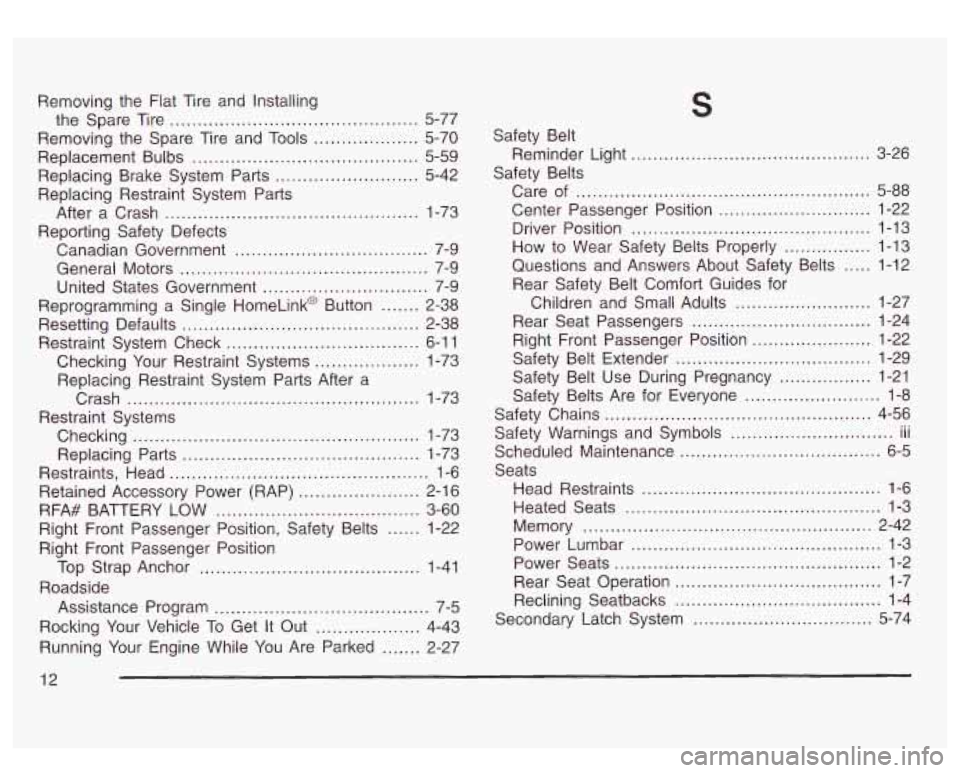
Removing the Flat Tire and Installing
the Spare Tire
............................................. 5-77
Replacement Bulbs
......................................... 5-59
Replacing Brake System Parts
.......................... 5-42
Replacing Restraint System Parts
After a Crash
.............................................. 1-73
Reporting Safety Defects
Canadian Government
................................... 7-9
General Motors
............................................. 7-9
United States Government
.............................. 7-9
Resetting Defaults
........................................... 2-38
Restraint System Check
................................... 6-1 1
Removing
the Spare Tire and Tools
................... 5-70
Reprogramming a Single HomeLink@ Button
....... 2-38
Checking Your Restraint Systems
................... 1-73
Replacing Restraint System Parts After
a
Crash ..................................................... 1 -73
Checking
.................................................... 1-73
Replacing Parts
........................................... 1-73
Retained Accessory Power (RAP)
...................... 2-1 6
Right Front Passenger Position, Safety Belts
...... 1-22
Right Front Passenger Position
Top Strap Anchor
........................................ 1-41
Roadside
Assistance Program
....................................... 7-5
Running Your Engine While You Are Parked
....... 2-27
Restraint
Systems
Restraints, Head
............................................... 1-6
RFA# BATTERY LOW
..................................... 3-60
Rocking Your Vehicle To Get It Out
................... 4-43
S
Safety Belt
Safety Belts Reminder
Light
........................................ 3-26
Care of
.................................................. 5-88
Center Passenger Position
............................ 1-22
Driver Position
............................................ 1-13
How to Wear Safety Belts Properly
................ 1-13
Questions and Answers About Safety Belts
..... 1-12
Rear Safety Belt Comfort Guides for
Children and Small Adults
......................... 1-27
Rear Seat Passengers
................................. 1-24
Right Front Passenger Position
...................... 1-22
Safety Belts Are for Everyone
......................... 1-8
Safety Warnings and Symbols
.............................. iii
Safety Belt Extender .................................... 1-29
Safety Belt Use During Pregnancy
................. 1-21
Safety Chains
................................................. 4-56
Scheduled Maintenance
.................................. 6-5
Seats
Head Restraints
....................... , ................. 1-6
Heated Seats
............................................... 1-3
Memory
..................................................... 2-42
Power Lumbar
.............................................. 1-3
Power Seats
................................................. 1-2
Rear Seat Operation
...................................... 1-7
Reclining Seatbacks
...................................... 1-4
Secondary Latch System
................................. 5-74
12